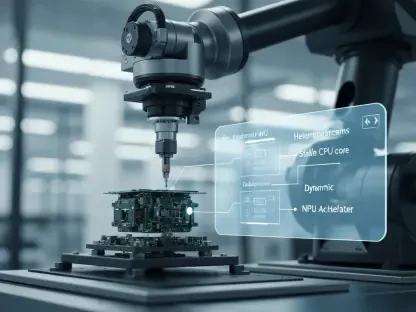The multifamily real estate industry, which includes apartment complexes and other multi-unit residential properties, stands at a critical juncture where technology is no longer just an option but a necessity for survival and growth. As operators grapple with persistent challenges such as staffing shortages, rising operational costs, and increasingly demanding resident expectations, artificial intelligence (AI) has emerged as a transformative force capable of addressing these issues head-on. This article offers a detailed roadmap for multifamily owners and managers seeking to construct an effective AI tech stack that not only enhances operational efficiency but also elevates the resident experience to new heights. By strategically integrating AI tools, businesses can streamline processes, reduce overhead, and maintain a competitive edge in a market that evolves at a relentless pace. The key lies in adopting a thoughtful approach that prioritizes specific needs over fleeting trends, ensuring that technology serves as a true enabler of success rather than a costly distraction.
Revolutionizing Operations with AI Tools
The scope of AI in multifamily operations extends far beyond simple automation, touching nearly every aspect of property management with remarkable potential for improvement. AI-driven chatbots, for instance, are redefining tenant engagement by handling leasing inquiries with speed and accuracy, often leading to higher conversion rates for prospective residents. Similarly, predictive maintenance systems use data analytics to foresee equipment issues before they escalate, minimizing downtime and costly repairs. In financial operations, tools like optical character recognition (OCR) are transforming accounts payable by automating invoice processing, slashing hours of manual labor into minutes of effortless efficiency. These advancements allow staff to redirect their focus from repetitive tasks to strategic initiatives that add greater value, such as building stronger resident relationships or optimizing property performance through informed decision-making.
Beyond individual tools, AI’s broader impact lies in its ability to integrate seamlessly across functions, creating a cohesive operational framework that drives results. In resident management, AI systems analyze feedback and behavior patterns to personalize services, enhancing satisfaction and retention rates. For revenue management, algorithms optimize pricing strategies based on market trends and occupancy data, ensuring maximum profitability without sacrificing competitiveness. Even facilities management benefits as AI coordinates schedules and prioritizes tasks to maintain properties at peak condition with minimal resource waste. The cumulative effect of these applications is a streamlined operation where technology acts as a force multiplier, empowering teams to achieve more with less while delivering a superior experience to residents. This holistic approach underscores the importance of viewing AI as a comprehensive solution rather than a series of isolated fixes.
Addressing Core Challenges in the Industry
One of the most pressing issues in the multifamily sector—staffing shortages—finds a powerful ally in AI technology, which offers innovative ways to bridge gaps in human resources. Digital leasing agents, for example, enable remote handling of tenant interactions, reducing the burden on on-site teams and allowing them to focus on face-to-face engagement that builds trust and community. Meanwhile, AI-powered training platforms support the onboarding of less experienced maintenance workers by providing targeted, accessible learning modules that quickly bring them up to speed. This not only expands the available talent pool but also ensures consistent service quality across properties, even in tight labor markets. Such solutions directly tackle the industry’s chronic challenge of finding and retaining skilled staff, offering flexibility that benefits both operators and employees.
Operational inefficiencies, another long-standing pain point, are also being dismantled through AI’s capacity to automate and optimize routine processes. Centralized operational models powered by AI allow for remote oversight of multiple properties, cutting down on redundant efforts and ensuring uniformity in service delivery. Additionally, AI tools streamline communication between departments, reducing delays in task execution and enhancing overall responsiveness to resident needs. By addressing these bottlenecks, operators can achieve significant cost savings while improving the speed and accuracy of their services, which in turn boosts resident satisfaction. This dual focus on labor challenges and process optimization highlights AI’s role as a practical solution to systemic issues, paving the way for more resilient and adaptable business models in the multifamily space.
Laying the Groundwork for AI Implementation
Successful AI adoption in multifamily operations begins with a thorough assessment of existing technology infrastructure and business processes to ensure a solid foundation. Many operators may already have access to AI capabilities within their current Property Management Systems (PMS), presenting a cost-effective entry point for innovation without the need for extensive overhauls. However, the effectiveness of these tools depends heavily on standardized workflows across properties to avoid discrepancies that could undermine results. Without consistent data capture methods or uniform operational protocols, even the most sophisticated AI solutions risk delivering uneven outcomes, leading to frustration rather than progress. A meticulous evaluation of current systems ensures that AI integration builds on strengths while addressing weaknesses systematically.
Equally critical to laying this groundwork is the alignment of AI initiatives with specific business objectives to maximize impact. Operators must resist the temptation to adopt technology for its own sake and instead focus on how it addresses defined challenges, whether that’s reducing maintenance response times or improving leasing efficiency. Establishing a clear vision for AI’s role within the organization helps prioritize investments and prevents resource waste on tools that don’t align with strategic goals. Furthermore, engaging stakeholders early in the process fosters buy-in and minimizes resistance to change, creating a culture receptive to technological advancement. This preparatory phase, though often overlooked in the rush to innovate, serves as the bedrock for sustainable AI integration, ensuring that every step forward is deliberate and aligned with long-term success.
Scaling AI for Portfolio-Wide Impact
As multifamily operators look to expand AI solutions across their portfolios, scalability emerges as a significant consideration that demands careful planning and measurable benchmarks. Key performance indicators (KPIs) such as leasing conversion ratios, resident satisfaction scores, or invoice processing speeds provide concrete metrics to evaluate the effectiveness of AI tools and identify areas for refinement. Without these benchmarks, it becomes challenging to gauge whether investments are yielding the desired outcomes or if adjustments are needed to better align with operational goals. An internal change champion plays a pivotal role here, acting as a bridge between technology and staff to drive adoption and ensure that AI initiatives remain focused on delivering value at every level of the organization.
Scaling also requires addressing the inherent variability across properties, which can complicate the uniform application of AI solutions. Differences in property size, resident demographics, or regional regulations may necessitate tailored approaches to implementation, rather than a one-size-fits-all strategy. Operators must invest in flexible systems that can adapt to these nuances while maintaining core functionalities, ensuring consistency without sacrificing relevance. Regular reviews of AI performance data further support this process, allowing for iterative improvements that refine scalability over time. By prioritizing measurable results and adaptability, multifamily businesses can extend the benefits of AI from a single property to an entire portfolio, creating a unified operational ecosystem that thrives on technological synergy.
Ensuring Security and Strong Vendor Relationships
In the rush to embrace AI, the importance of data security cannot be overstated, as the multifamily industry handles vast amounts of sensitive resident and financial information that must be protected. Choosing vendors with a deep understanding of the sector’s unique needs is essential, as is ensuring that their solutions integrate smoothly with existing systems to avoid vulnerabilities. Robust cybersecurity measures, though sometimes costlier, are a non-negotiable investment to prevent data breaches or unauthorized access that could jeopardize trust and compliance. Operators must conduct thorough due diligence on potential partners, evaluating their track record on privacy and their commitment to safeguarding information in an increasingly digital landscape.
Beyond security, the strength of vendor relationships directly influences the success of AI integration, as these partnerships provide the expertise and support needed for long-term viability. Vendors who prioritize ongoing collaboration and offer scalable solutions tailored to multifamily operations can help navigate the complexities of technology adoption, from initial setup to future upgrades. Transparent communication about costs, capabilities, and limitations fosters trust, ensuring that operators are not blindsided by hidden challenges down the line. By balancing innovation with caution, and by selecting partners who align with both technical and ethical standards, multifamily businesses can build a tech stack that not only drives efficiency but also upholds the integrity of their operations in a competitive market.
Navigating the Future of AI in Multifamily Real Estate
Looking ahead, the trajectory of AI in the multifamily sector points toward increasingly sophisticated systems that mimic human decision-making, offering unprecedented autonomy in operational management. This evolution from basic automation to advanced agentic AI promises to further reduce manual workloads, allowing staff to focus on strategic priorities that enhance resident experiences. However, embracing these advancements requires a balanced approach that tempers enthusiasm with pragmatic planning, ensuring that foundational issues like inconsistent data practices are resolved before scaling up. Operators must remain vigilant, continuously assessing the relevance of emerging tools to their specific needs rather than adopting every innovation that hits the market.
Reflecting on the journey so far, the adoption of AI in this industry has already demonstrated tangible benefits in addressing labor constraints and streamlining processes, as evidenced by past implementations of chatbots and predictive systems. The challenge now lies in sustaining this momentum through actionable next steps, such as investing in staff training to complement AI tools and regularly updating KPIs to reflect evolving goals. Strong vendor partnerships, coupled with a commitment to data security, will continue to be indispensable in navigating potential pitfalls. Ultimately, the focus should remain on crafting a tech stack that evolves with the industry, ensuring that multifamily operators are equipped to meet future demands with confidence and clarity.









